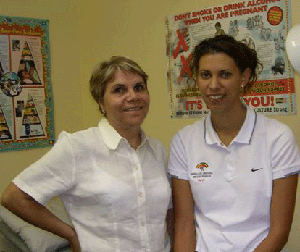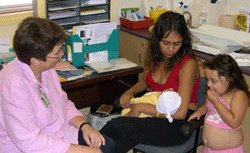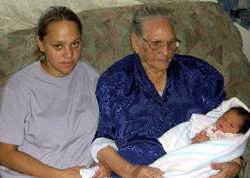Mimini and Burri Childbirth Centre



<b>1 Introduction</b><p>
1.1 Historically the hospital has not been a comfortable place for Koori women to have their babies. Only twenty years ago it was normal practice for Koori women not to be admitted to the wards, but to be put out on the verandahs of the hospital. The difficulty of the hospital in accepting the role of the extended family and other cultural differences is still a problem. Most Koori women do not expect to find a supportive culture within the hospital. The same discomfort exists for ante-natal programs with the result that Indigenous women came to give birth unprepared and with subsequently higher numbers of babies that did not go full term with many admitted to Special Care Nurseries. Rumbalara Aboriginal Medical Service took the lead towards improving outcomes by establishing a Pregnancy Care Program operating with Goulburn Valley Hospital since 1992. Now we seek to establish a fully fledged and independent birthing centre focusing on better health outcomes for mothers and babies and a more holistic Indigenous approach to child birth.<p>
1.2 As Rita Anne Davies has recently observed both Indigenous and non-Indigenous women are supportive of less medicalised childbirth: childbirth culture and the role of the midwife within it are part of a vibrant and developing process. In the twenty-first century, midwives provide an essential service and to act as principal birth practitioner in the majority of uncomplicated childbirth. university courses are available that focus on preparing a midwife practitioner rather than a nurse who practices midwifery."
<i>She did what she could</i> ... A history of the regulation of midwifery practice, 2003, Ph.d thesis<p>
1.3 The Alukura Birthing Agreement (2002) represented a major step forward for Indigenous women in harmony with a less medicalised and inclusive culture of childbirth. The Alukura Birthing Agreement was signed between Congress Alukura and the Alice Springs Hospital. The agreement was designed to encourage mutual respect and understanding between the two providers of antenatal and obstetric care. It will provide Alukura midwives visiting privileges at the hospital to manage the births of Alukura clients and encourages Aboriginal women to exercise their right to incorporate cultural practices and beliefs in the birthing process. <p>
1.4 The Indigenous population is young when compared to the non-Indigenous population. It is important to dedicate a new set of services to support young women and families in the Goulburn Valley and other population centres for Indigenous peoples.<p>
<b>2 Mimini and Burri Childbirth Centre</b><p>
2.1 Our aim is to develop a birthing centre under the auspices of Rumbalara Aboriginal Medical Services (RAMS). We propose to establish an Advisory Committee with hospital representation from midwifery and obstetric divisions. <p>
2.2 The provision of an appropriate maternity service has been a priority at the Rumbalara Aboriginal Cooperative for a number of years (Campbell, 2000) due to the poor Koori perinatal and general health statistics. These statistics along with the limited use of mainstream health services by Koori women (for example not one Koori woman has attended Childbirth Education Classes provided by GVH) demands the development of innovative models of care by Aboriginal Community Controlled Health Services supported by mainstream health services. The success of the present Pregnancy Support Program at RAMS plus information from a number of independent evaluations and governmental reports (Campbe11, 2000, O'Donnell 2000, Koori Health unit, 1996, Standing Committee on Family and Community Affairs, Government of Australia 2000) highlights areas for expansion and improvement. The proposed Mimini and Burri Program by Rumbalara Aboriginal medical Service is therefore the cumulation of the growth and success of the present pregnancy Support Program and the identification of further developments to meet the needs of the Aboriginal Community in the Goulburn Valley and surrounding districts.<p>
2.3 Key Objectives of the Mimini and Burri Childbirth Centre are:<p>
<ul>
<li>2.3.1 to support Indigenous childbirth culture and the recognition of wider family roles and responsibilities in relation to child birth and child rearing;</li>
<li> 2.3.2 to increase the proportion of babies who go through to full term before delivery;</li>
<li> 2.3.3 to encourage and promote regular attendance at ante-natal and post-natal sessions at the Goulburn Valley Base Hospital and with the General Practioner of their choice;</li>
<li> 2.3.4 to encourage and promote healthy lifestyles, improved diet, better maternal health care and early identification of treatable conditions;</li>
<li> 2.3.5 to increase immunisation and breast feeding levels to those attained by the mainstream population as a minimum;</li>
<li>2.3.6 to offer access to family planning education and parenting skills as part of the 0-5 program offered through Rumbalara.</li>
</ul><p>
2.4 The guiding principles of the centre would be:
<ul><p>
<li>2.4.1 recognition of Yorta Yorta nations as traditional custodians with strong cultural traditions and practices</li>
<li>2.4.2 empowerment of Aboriginal people and their community to act on their own behalf with adequate services and infrastructure</li>
<li>2.4.3 mutual respect for supporting health and governmental units</li>
<li>2.4.4 a strong research and evaluation program</li>
</ul> <p>
2.5 The Rumbalara Birthing Centre would provide an alternative option for those Indigenous and non-Indigenous women wanting to have a birthing experience with a midwife outside of the hospital ward. While non-Indigenous women would be able to use the Rumbalara Birthing Centre the target groups would be 1) pregnant Koori women and non-Koori partners of Koori men; 2) Koori men who are partners of the pregnant women; 32) older Koori women whose attitudes on breast-feeding and diet are influential on the prevailing culture.<p>
2.6 The Rumbalara Birthing Centre would maintain a strong and effective working relationships with the Midwifery, Obstetric and Paedetric sections of the hospital. The Birthing Centre would be an integrated part of the Rumbalara Health Team. The project members will report directly to the Health Services Coordinator who reports to the Board through the Administrator. The Board of Directors have community responsibility for the development, success or failure of all programs, as well as statutory responsibility to funding bodies and State and Commonwealth Authorities.<p>
<b>3. Operations</b><p>
A detailed model of care is available with the following broad guidelines.<p>
<b>3.1 Midwives working in the Mimini and Burri Program will utilise principles of Primary Health Care (Wass.2000) and practice according to:</b><br>
3.1.1 The Code of Practice for Midwives in Victoria <br>
3.1.2 Australian College of Midwives Inc Standards for Midwifery Practice<br>
3.1.3 National Aboriginal Community Controlled Health Organisation's definition of health.<br>
3.1.4 Rumbalara Aboriginal Medical Service and Goulburn Valey Health's Midwife Accreditation Guidelines.<p>
<b>3.2 Admission to Miminis and Burris Program.</b><br>
<br>
3.2.1 Women will self refer to Rumbalara Aboriginal Medical Service and / or be referred from GVH or a GP. It is acknowledged that non-Koorie women will access the service but the focus will be on Koorie families.<br>
<br>
3.2.2 Admittance to program will depend on:<br>
3.2.2.1 Woman being a public patient<br>
3.2.2.2 Availability of places<br>
3.2.2.3 Consent of woman<p>
3.2.3 Antenatal Care, education and discharge planning<br>
<br>
3.2.3.1 The RAMS / GVH / DRH Selection Criteria and Guidelines for consultation / referral to the obstetrician/ paediatrician will be used.<br>
3.2.3.2 Midwife / Koori Pregnancy Support Worker antenatal visits will be arranged at mutually convenient times for the midwife / Koori Pregnancy Support Worker and the woman (and her family if desired) at either: Rumbalara Aboriginal Medical Service, the woman's home or at GVH Antenatal Clinic (if specialist services required that are unavailable at RAMS).<br>
3.2.3.3 one on one antenatal education will be provided by the midwives and Koori Health Worker with the view of providing culturally appropriate classes / health promotion in the future.<br>
3.2.3.4 Discharge planning will be an important aspect of the antenatal care provided and will commence at the first visit.<br>
<br>
3.2.4 Consultant visit and referral patterns.<br>
<br>
3.2.4.1 The RAMS / GVH / DRH Selection Criteria and Guidelines for consultation / referral to the obstetrician / paediatrician will be used.<br>
3.2.4.2 If a woman is referred to the consultant and this results in transfer of care the midwife will ccntinue to provide midwifery care either in a shared care arrangement or a consultant care / midwife support one.<br>
3.2.4.3 A consultant visit in early pregnancy will be arranged following initial visit/s to the midwife. All routine antenatal pathology test results vJlI be available for the consultant visit.<br>
<b>3.3 Admission to Labour Ward.</b><br>
<br>
3.3.1 Women in the Mimini's and Burri's Program will (where possible) on admission be cared for by the RAMS Midwife or GVH Associate Midwife.<br>
3.3.2 If the woman's labour is abnormally long and/or sre is transferred to obstetric care the midwife will remain as part of the team.<br>
3.3.3 Baby transferred to paediatric care as per protocol.<p>
<b>3.4 Post Natal Care</b><br>
<br>
3.4.1 as per normal protocols<p>
<b>3.5 Discharge from GVH</b><br>
<br>
3.5.1 if no complication and woman and baby remain under Miminis and Burri's Midwife Care then discharge will be at the RAMS Midwife's discretion<br>
3.5.2 Examination of the baby to be performed by RMO unless midwife educated in procedure and deemed competent <br>
3.5.3 Women referred to MCHN in normal manner.<br>
3.5.4 Continuity of care continued with home postnatal visits. <br>
3.5.5 6 week wellness woman and baby check organised at RAMS.<p>
